light JAGUAR XJ6 1994 2.G Repair Manual
[x] Cancel search | Manufacturer: JAGUAR, Model Year: 1994, Model line: XJ6, Model: JAGUAR XJ6 1994 2.GPages: 521, PDF Size: 17.35 MB
Page 376 of 521
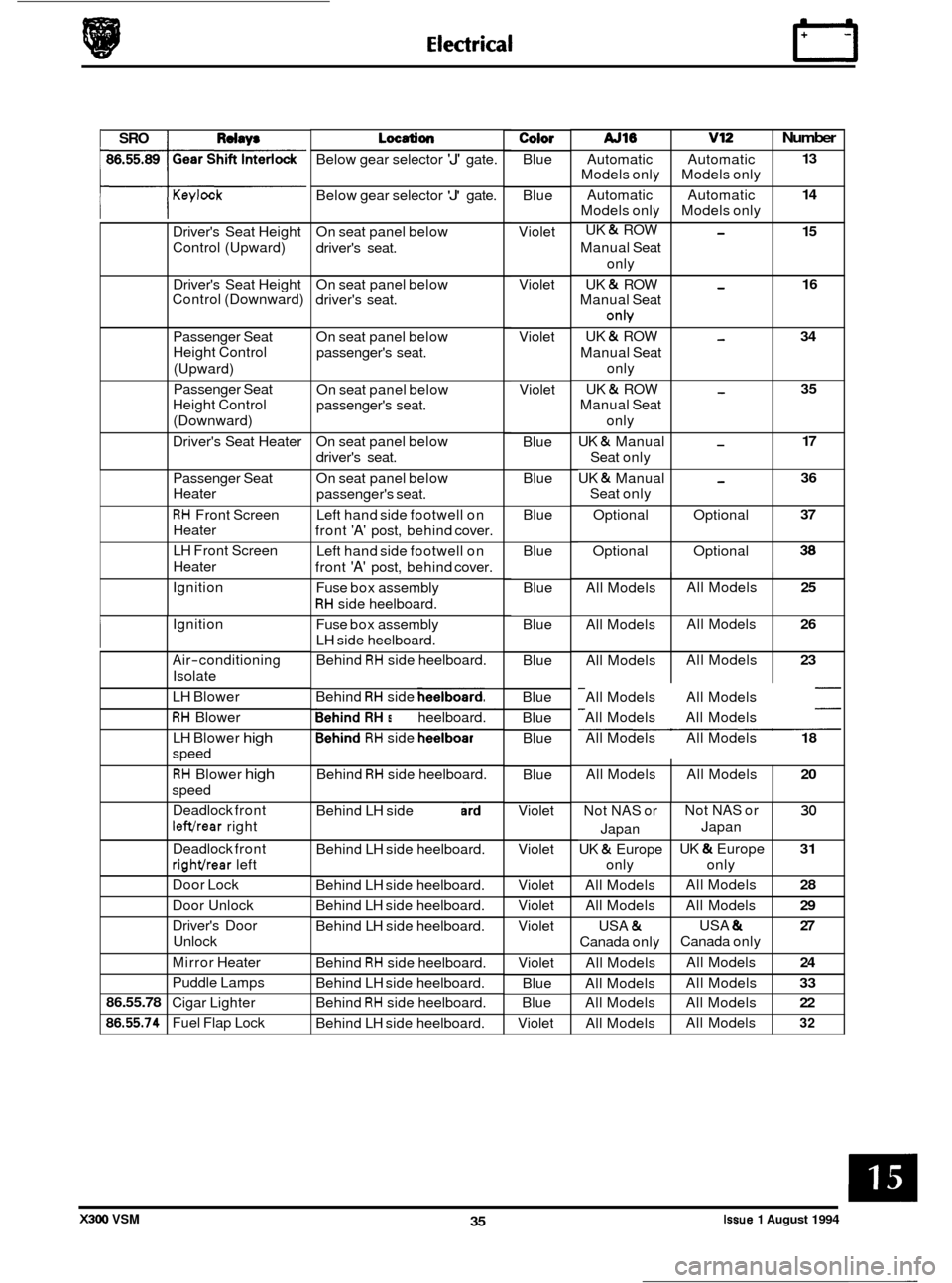
I SRO I Rdw* AJ16 v12
Automatic Automatic
Models only Models only
Automatic Automatic
Models only Models only
UK
& ROW -
Manual Seat
only
UK
& ROW -
Manual Seat
onh/
UK & ROW -
Manual Seat
only
Manual Seat
only
UK
& Manual -
Seat only
UK
& Manual -
Seat only
UK
& ROW -
Optional
Optional
Optional Optional
Keylock
Number
13
14
15
16
34
35
17
36
37
38
Driver's Seat Height
Control (Upward)
Driver's Seat Height
Control (Downward)
Passenger Seat
Height Control (Upward)
Passenger Seat
Height Control
(Downward)
Driver's Seat Heater
All Models
All Models
All Models
Passenger Seat
Heater
RH Front
Screen
Heater
LH Front Screen
Heater
Ignition All Models
25
All Models 26
All Models 23
Ignition
Air
-conditioning
Isolate
LH Blower
RH Blower
LH Blower
high
speed
RH Blower high
speed
Deadlock front
lefthear right All
Models All Models
20
Below gear selector 'J' gate.
Not NAS or
Japan
UK
& Europe
only
All Models
All Models
USA
&
Canada only
All Models
All Models
All Models
All Models
Below
gear selector
'J' gate.
Not NAS or
30
UK & Europe 31
All Models 28
All Models 29
USA & 27
All Models 24
All Models 33
All Models 22
All Models 32
Japan
only
Canada only
On
seat panel below
driver's seat.
86.55.78
86.55.74
On seat panel below
driver's seat.
Deadlock front
righthear left
Door Lock
Door Unlock
Driver's Door
Unlock
Mirror Heater
Puddle Lamps
Cigar Lighter
Fuel Flap Lock On
seat panel below
passenger's seat.
On seat panel below
passenger's seat.
On seat panel below
driver's seat.
On seat panel below
passenger's seat.
Left hand side footwell on
front
'A' post, behind cover.
Left hand side footwell on
front
'A' post, behind cover.
Fuse box assembly
RH side heelboard.
Fuse box assembly
LH side heelboard.
Behind
RH side heelboard.
Behind
RH side heelboard.
Behind RH side heelboard.
Behind
RH side heelboard.
Behind
RH side heelboard.
Behind LH side heelboard.
Behind LH side heelboard.
Behind LH side heelboard.
Behind LH side heelboard.
Behind LH side heelboard.
Behind
RH side heelboard.
Behind LH side heelboard.
Behind
RH side heelboard.
Behind LH side heelboard.
Color
Blue
Blue
Violet
Violet
Violet Violet Blue Blue
Blue
Blue
Blue
Blue
Blue
Blue
Blue Blue
Blue
Violet
Violet
Violet
Violet
Violet
Violet Blue
Blue
Violet All
Models All Models
All Models All Models
All Models All Models
18
X300 VSM 35 Issue 1 August 1994
Page 389 of 521

Specificat ion
Electrical Equipment (continued)
Starter
Make and type ..................................................... Bosch DW 1,7K
Free spin speed .................................................... 3000 RPM
Free spin current ................................................... 90A maximum
Load
running current ............................................... 420A maximum
Stall
............................................................... 1050A
Make and type ..................................................... Magneti Marelli M80R
Free spin speed .................................................... 2650 RPM
Free spin current ................................................... 75A maximum
Load
running current ............................................... 375A maximum
Stall
............................................................... 1000A
lindshield Wiper Motor
Make ............................................................. Trico
Light running speed: (after 60 seconds from cold)
Slowspeed
....................................................... 40-48cycles
Fast speed ........................................................ 57 -67 cycles
Light
running current:
Fastspeed
......................................................... 5A max.
Slow speed ........................................................ 2.5A max.
Page 397 of 521
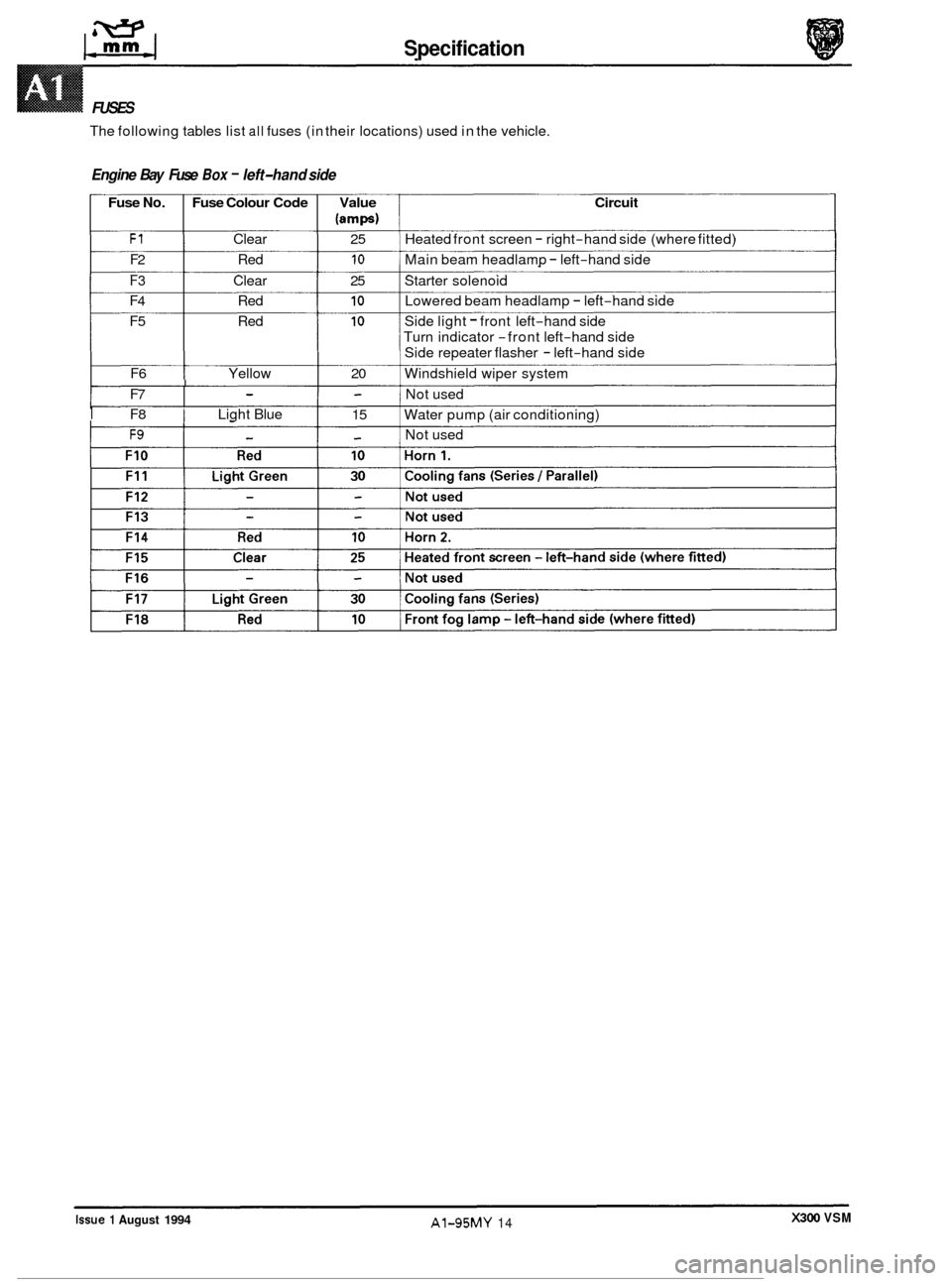
Specification
w IfrnrnJ
FUSES
The following tables list all fuses (in their locations) used in the vehicle.
Engine Bay Fuse Box - left-hand side
Fuse No. Fuse Colour Code Value Circuit
lamps)
F1 Clear 25 Heated front screen - right-hand side (where fitted)
F2 Red 10 Main beam headlamp - left-hand side
F3 Clear 25 Starter solenoid
F4 Red 10 Lowered beam headlamp - left-hand side
F5 Red 10 Side light - front left-hand side
Turn indicator
-front left-hand side
Side repeater flasher
- left-hand side
F6 Yellow 20 Windshield wiper system
I F8 I Light Blue
I Not used
F9 - - Not used
- - F7
15
Water pump (air conditioning) I - -
-l
X300 VSM Issue 1 August 1994 AI-95MY 14
Page 398 of 521

0
Engine Bay Fuse Box - right-hand side
Fuse No. Fuse Colour Code
- F1
F2 Red
F3
F4 Red
F5 Red
-
F6 Tan
F7 Clear
F8 Red
F9 -
FIO Tan
F12 Red
F13 Red
F14 Red F15
-
F16 Red
F17 Light Green
F18 Red
Value
(amps)
10
10
10
5
25
10
-
5
20
10
10
10
10
30
10
Circuit
Not used
Main beam headlamp
- right-hand side
Not used
Lowered beam
headlamD - riaht-hand side ."
Side light -front right-hand side
Turn indicator
-front right-hand side
Side repeater flasher
- right-hand side
Engine control module
(ECM)
Air pump (6 cyl. - where fitted)
Ignition coils
(VIZ)
Air conditioning clutch
Not used
Generator
Front lighting control module
- right-hand
Air conditioning clutch
Windshield wash
J headlamp power wash heaters and relays
Engine management system relay supply
Injectors
Engine management system
Starter relay Ignition coil sensing and air pump relay (6
cyl.)
Fuel injection relay
Engine management sensing
(VIZ)
Windshield washer pump
Lambda heaters
Idle speed control valve
Not used
Air pump control
Solenoid vacuum valve
(VIZ)
Water pump (supercharged)
Headlamp power wash pump
Front fog lamp
- right-hand side (where fitted)
0
0
Issue 1 August 1994 X300 VSM AI-95MY 15
Page 399 of 521

Specification
Rear Compartment Fuse Box - left-hand side heelboard
Fuse No. Fuse Colour Code Value Circuit
(amps)
I F1 I - I - lNot used
F2 Red 10 Heated door mirrors
F3 Light Blue 15 Seat motors - right-hand side
F4 Light Blue 15 Seat motors - right-hand side
F5 Red 10 Instrument pack
F6 Tan 5 Seat control modules (SCMs)
Low power door switch pack
Mirror motors
Instrument
illumination dimmer
F7 Light Green 30 Anti-lock braking system pump (via ABS / TC Control Module)
F8 - - Not used
F9 Yellow 20 Cigar lighters
FIO Tan 5 Speed (cruise) control (where fitted)
F11 Yellow 20 Air conditioning blower motor - left-hand
F12 Tan 5 Instrument pack
F13 Light Blue 15 Steering column -electric power tilt / axial operation (where
j fitted) 1 I I F14 Red 10 i Automatic transmission ignition supply I I I F15 Light Green 30 I Window lift (front and rear) - left-hand side
Tan
I 5 1 Anti-lock braking system (ABS) ignition supply
I F17 1 - I - lNot used
Red
I 10 I Air conditioning supply
Rear Compartment Fuse Box - left-hand side heelboard ~~
X300 VSM Issue 1 August 1994 AI-95MY 16
0
0
0
Page 400 of 521
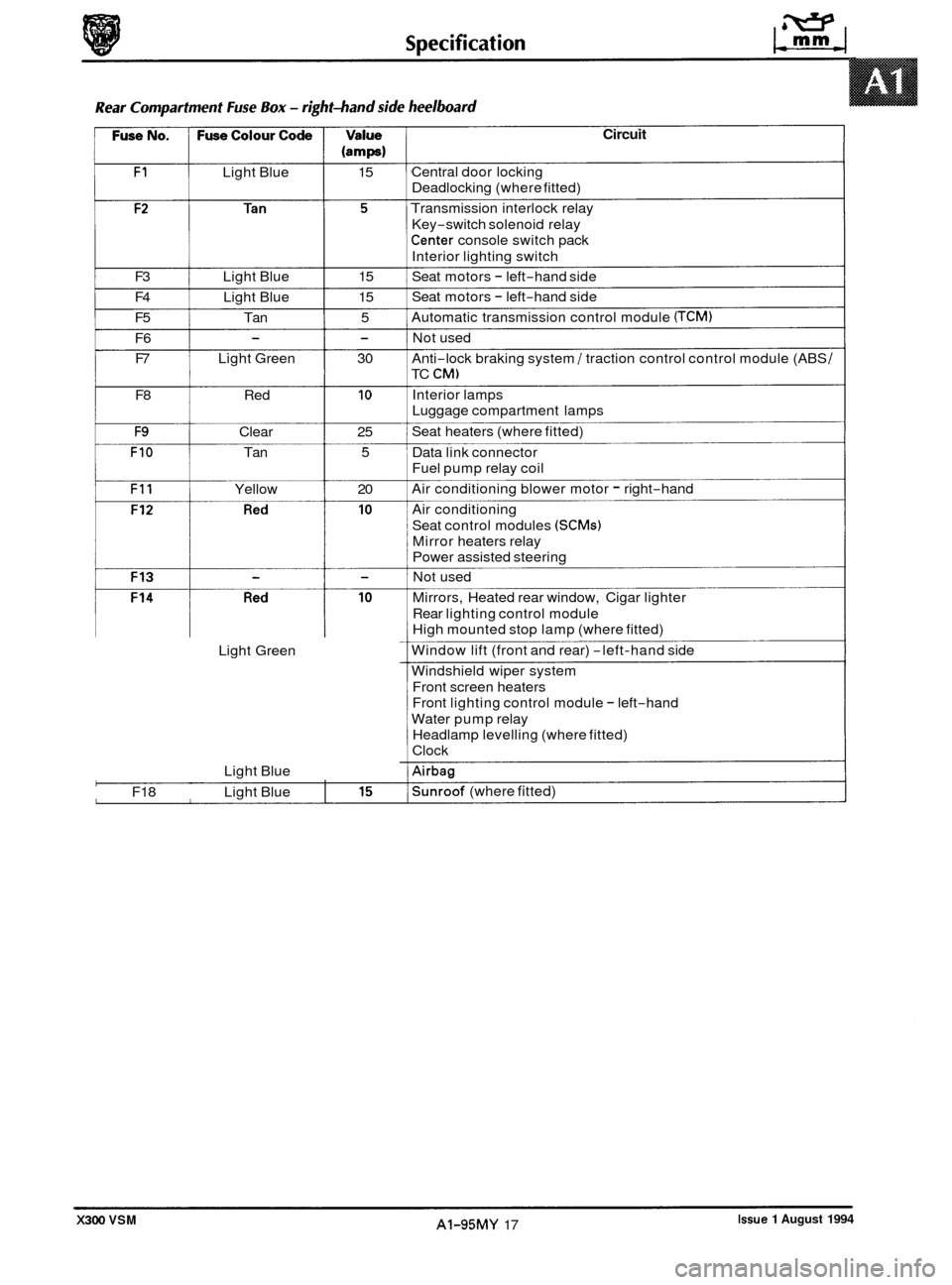
(amps)
F1 Light Blue 15
F3 Light Blue 15
F4 Light Blue 15
F5 Tan 5
F6 F7 Light Green 30
- -
F8 Red 10
F9 Clear 25
FIO Tan 5
F11 Yellow 20 0
Light Green
Light Blue
F18 Light Blue
0'
I
Circuit
Central door locking
Deadlocking (where fitted)
Transmission interlock relay
Key
-switch solenoid relay
Center console switch pack
Interior lighting switch
Seat motors
- left-hand side
Seat motors
- left-hand side
Automatic transmission control module
(TCM)
Not used
Anti
-lock braking system / traction control control module (ABS /
TC CM)
Interior lamps
Luggage compartment lamps
Seat heaters (where fitted)
Data link connector
Fuel pump relay coil
Air conditioning blower motor
- right-hand
Air conditioning
Seat control modules
(SCMs)
Mirror heaters relay
Power assisted steering
Not used
Mirrors, Heated rear window, Cigar lighter
Rear lighting control module
High mounted stop lamp (where fitted)
Window lift (front and rear)
-left-hand side
Windshield wiper system Front screen heaters
Front lighting control module
- left-hand
Water pump relay
Headlamp levelling (where fitted)
Clock
Airbag
Sunroof (where fitted)
Issue 1 August 1994 AI-95MY 17 X300 VSM
Page 401 of 521
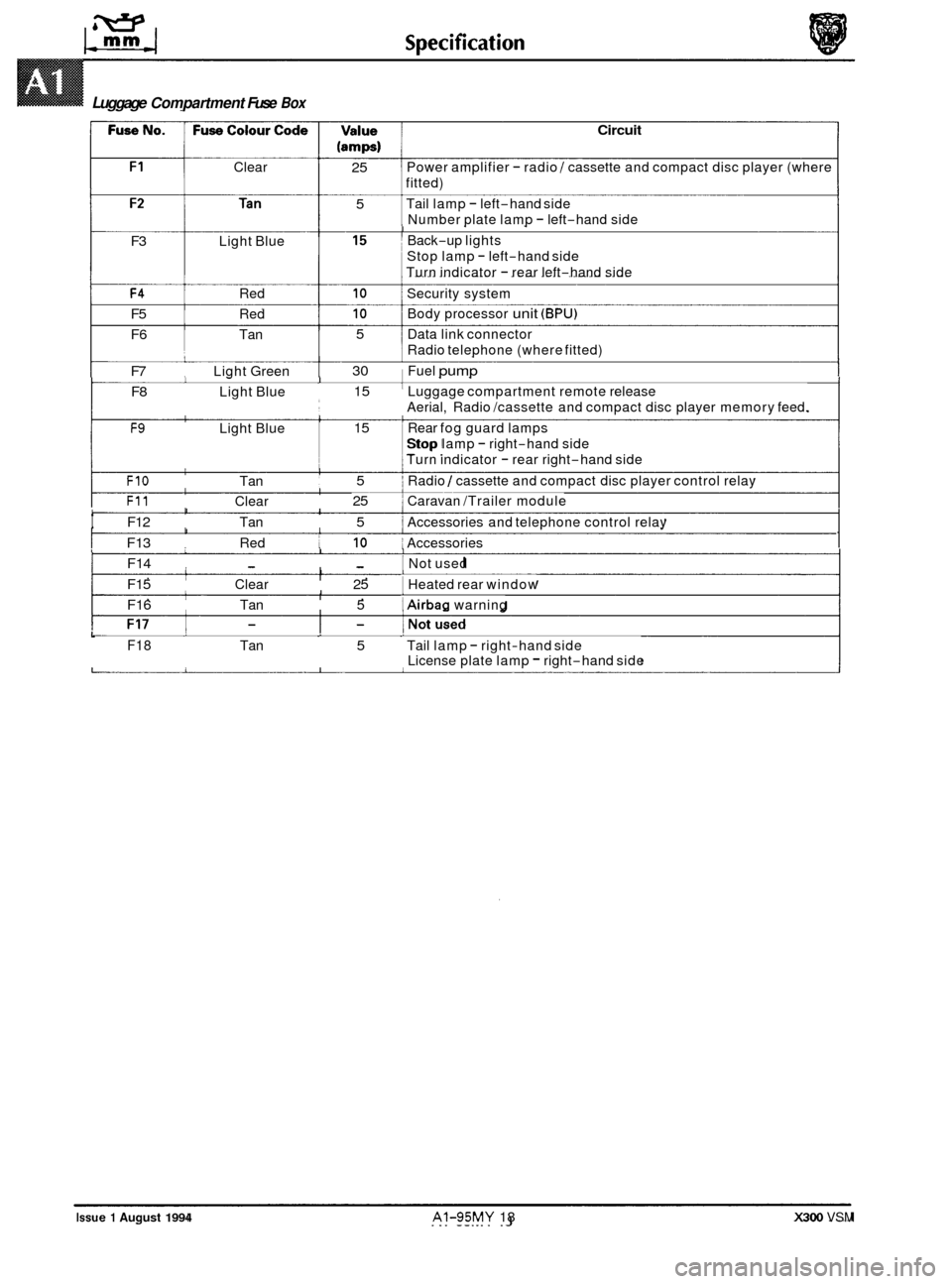
Clear
(amps) 1
Circuit
I
25 5 Power amplifier - radio / cassette and compact disc player (where
fitted)
Tail lamp
- left-hand side
Number plate lamp
- left-hand side I Back-up lights
Stop lamp
- left-hand side
Turn indicator
- rear left-hand side
F3 Light Blue
F4 Red 10 Security system
F5 Red 10 Body processor unit (BPU)
F6 Tan 5 Data link connector
F7 Light Green 30 Fuel pump
F8 Light Blue 15 Luggage compartment remote release
F9 Light Blue 15 i Rear fog guard lamps
Radio
telephone (where fitted)
1
Aerial, Radio /cassette and compact disc player memory feed.
Stop lamp
- right-hand side
1 Turn indicator - rear right-hand side I.
I FIO Tan 5 i Radio / cassette and compact disc player control relay
F11 Clear 25 1 Caravan /Trailer module I
t F12 Tan 5 ~ Accessories
and telephone control relay I I
I I I F13 Red 10 ~ Accessories 1 1 I I F14 - - I Not used 1 I I F15 Clear 25 1 Heated
rear window I I I F16 Tan 5 1 Airbag warning
Luggage Compartment Fuse Box
Issue 1 August 1994 AI-95MY 18 X300 VSM
L F18 Tan 5 Tail lamp - right-hand side
License plate lamp - right-hand side
Page 413 of 521
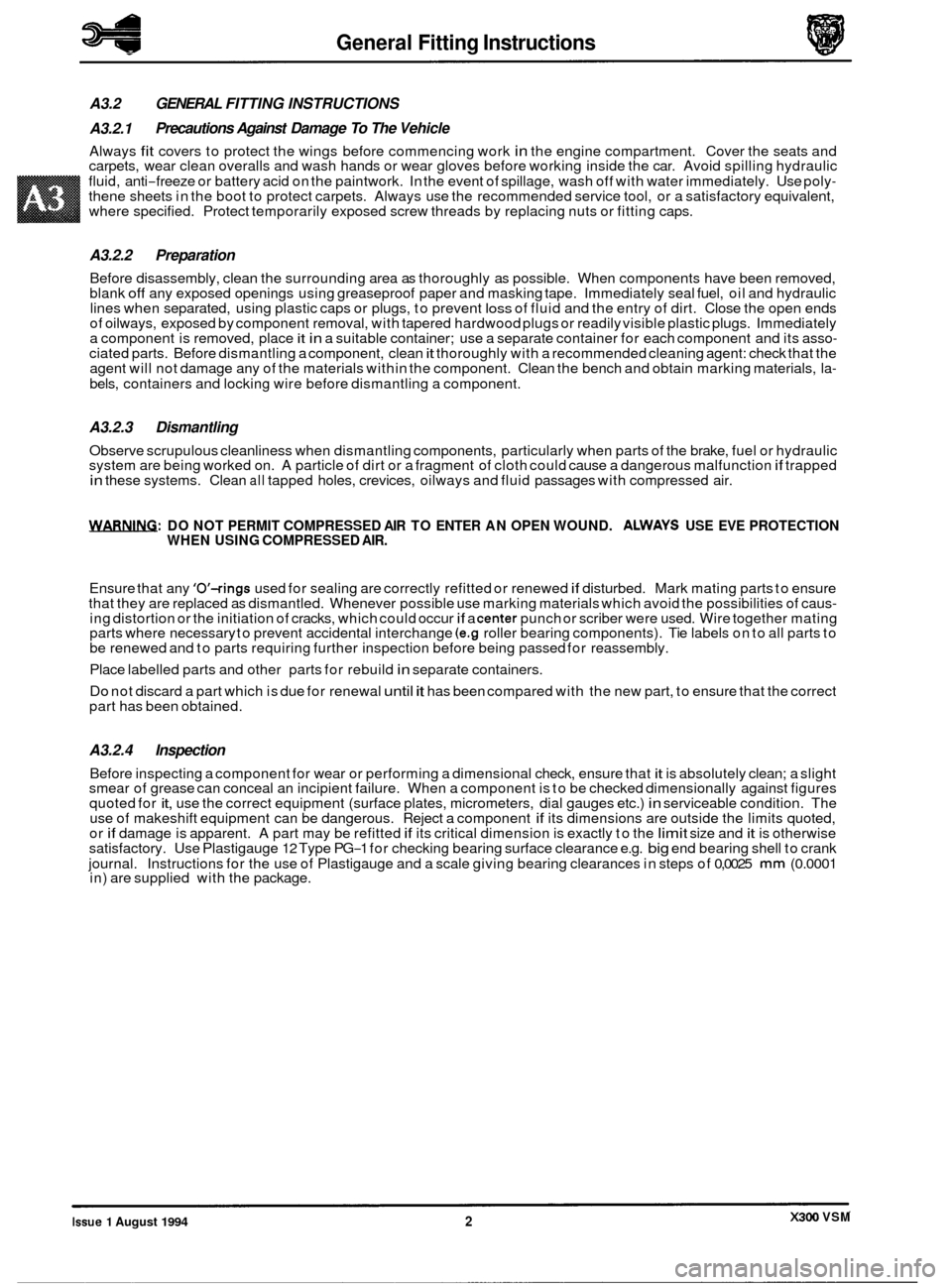
General Fitting Instructions
A3.2 GENERAL FITTING INSTRUCTIONS
A3.2.1
Always fit covers to protect the wings before commencing work in the engine compartment. Cover the seats and
carpets, wear clean overalls and wash hands or wear gloves before working inside the car. Avoid spilling hydraulic
fluid, anti
-freeze or battery acid on the paintwork. In the event of spillage, wash off with water immediately. Use poly- thene sheets in the boot to protect carpets. Always use the recommended service tool, or a satisfactory equivalent,
where specified. Protect temporarily exposed screw threads by replacing nuts or fitting caps.
Precautions Against Damage To The Vehicle
A3.2.2 Preparation
Before disassembly, clean the surrounding area as thoroughly as possible. When components have been removed,
blank off any exposed openings using greaseproof paper and masking tape. Immediately seal fuel, oil and hydraulic
lines when separated, using plastic caps or plugs, to prevent loss of fluid and the entry of dirt. Close the open ends
of oilways, exposed by component removal, with tapered hardwood plugs or readily visible plastic plugs. Immediately
a component is removed, place
it in a suitable container; use a separate container for each component and its asso- ciated parts. Before dismantling a component, clean it thoroughly with a recommended cleaning agent: check that the
agent will not damage any of the materials within the component. Clean the bench and obtain marking materials, la-
bels, containers and locking wire before dismantling a component.
A3.2.3 Dismantling
Observe scrupulous cleanliness when dismantling components, particularly when parts of the brake, fuel or hydraulic
system are being worked on. A particle of dirt or a fragment of cloth could cause a dangerous malfunction if trapped in these systems. Clean all tapped holes, crevices, oilways and fluid passages with compressed air.
WRNIFLG: DO NOT PERMIT COMPRESSED AIR TO ENTER AN OPEN WOUND. ALWAYS USE EVE PROTECTION
WHEN USING COMPRESSED AIR.
Ensure that any 'O'-rings used for sealing are correctly refitted or renewed if disturbed. Mark mating parts to ensure
that they are replaced as dismantled. Whenever possible use marking materials which avoid the possibilities of caus- ing distortion or the initiation of cracks, which could occur if a center punch or scriber were used. Wire together mating
parts where necessary to prevent accidental interchange (e.g roller bearing components). Tie labels on to all parts to
be renewed and to parts requiring further inspection before being passed for reassembly.
Place labelled parts and other parts for rebuild
in separate containers.
Do not discard a part which is due for renewal until it has been compared with the new part, to ensure that the correct
part has been obtained.
A3.2.4 Inspection
Before inspecting a component for wear or performing a dimensional check, ensure that it is absolutely clean; a slight
smear of grease can conceal an incipient failure. When a component is to be checked dimensionally against figures
quoted for
it, use the correct equipment (surface plates, micrometers, dial gauges etc.) in serviceable condition. The
use of makeshift equipment can be dangerous. Reject a component if its dimensions are outside the limits quoted,
or if damage is apparent. A part may be refitted if its critical dimension is exactly to the limit size and it is otherwise
satisfactory. Use Plastigauge 12 Type PG-1 for checking bearing surface clearance e.g. big end bearing shell to crank
journal. Instructions for the use of Plastigauge and a scale giving bearing clearances in steps of
0,0025 mm (0.0001
in) are supplied with the package.
0
0
0
X300 VSM Issue 1 August 1994 2
Page 416 of 521
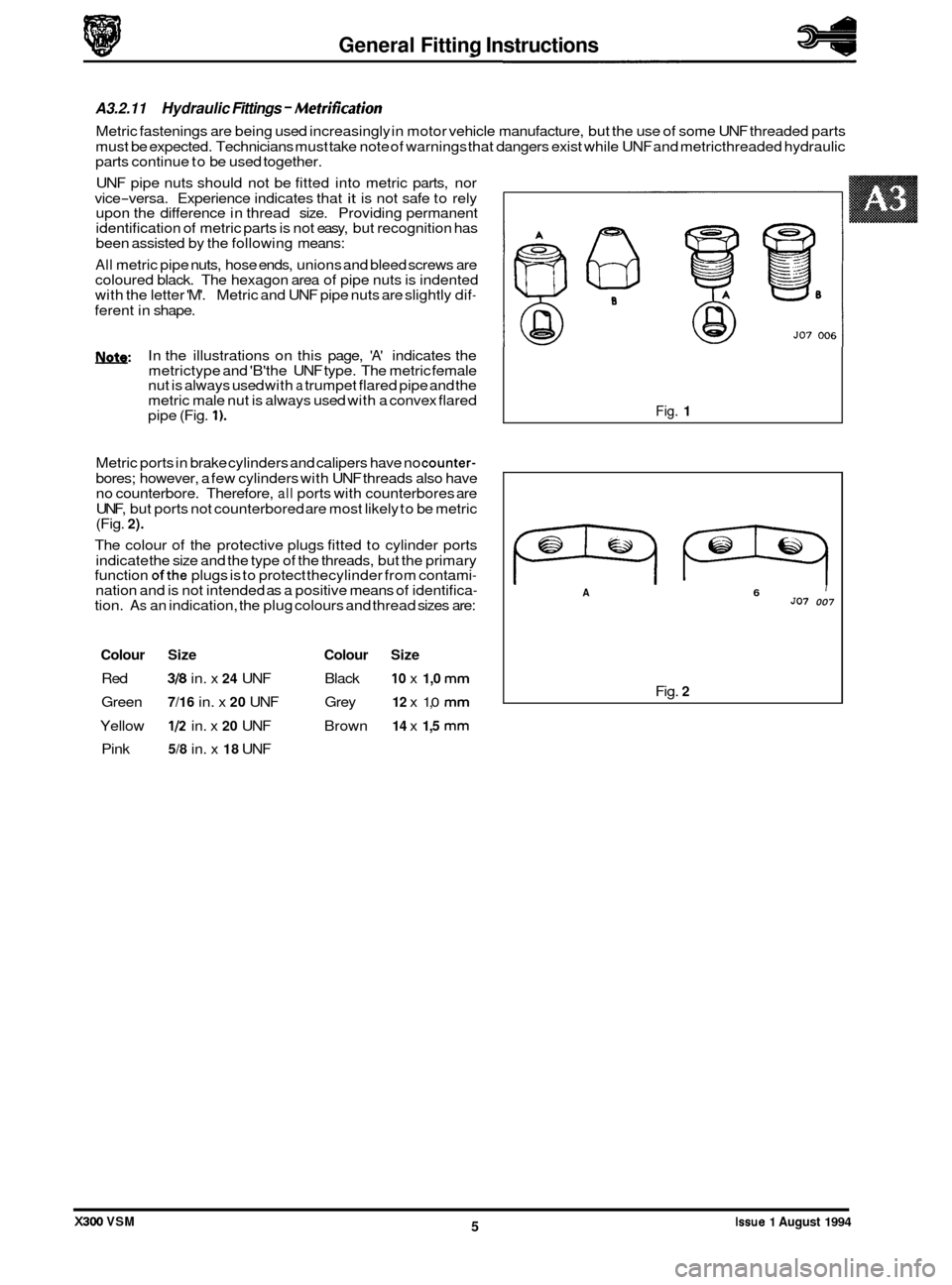
General Fitting Instructions
Issue 1 August 1994 5 X300 VSM I
0
0
0
0
A3.2.11 Hydraulic Fittings - Metrification
Metric fastenings are being used increasingly in motor vehicle manufacture, but the use of some UNF threaded parts
must be expected. Technicians must take note of warnings that dangers exist while UNF and metricthreaded hydraulic
parts continue to be used together.
UNF pipe nuts should not be fitted into metric parts, nor
vice
-versa. Experience indicates that it is not safe to rely
upon the difference in thread size. Providing permanent
identification of metric parts is not easy, but recognition has
been assisted by the following means:
All metric pipe nuts, hose ends, unions and bleed screws are
coloured black. The hexagon area of pipe nuts is indented
with the letter 'M'. Metric and UNF pipe nuts are slightly dif
-
ferent in shape.
hlnfe: In the illustrations on this page, 'A' indicates the
metrictype and 'B'the UNF type. The metric female
nut is always used with
a trumpet flared pipe and the
metric male nut is always used with a convex flared
pipe (Fig.
1).
Metric ports in brake cylinders and calipers have no counter-
bores; however, a few cylinders with UNF threads also have
no counterbore. Therefore, all ports with counterbores are
UNF, but ports not counterbored are most likely to be metric
(Fig.
2).
The colour of the protective plugs fitted to cylinder ports
indicate the size and the type of the threads, but the primary
function
ofthe plugs is to protect thecylinder from contami- nation and is not intended as a positive means of identifica- tion. As an indication, the plug colours and thread sizes are:
Colour Size Colour Size
Red 318 in. x 24 UNF Black 10 x 1,0 mm
Green 7/16 in. x 20 UNF Grey 12 x 1,0 mm
Yellow 112 in. x 20 UNF Brown 14 x 1,5 mm
Pink 5/8 in. x 18 UNF
Fig. 1
A 6 I 507 007
Fig. 2
Page 417 of 521
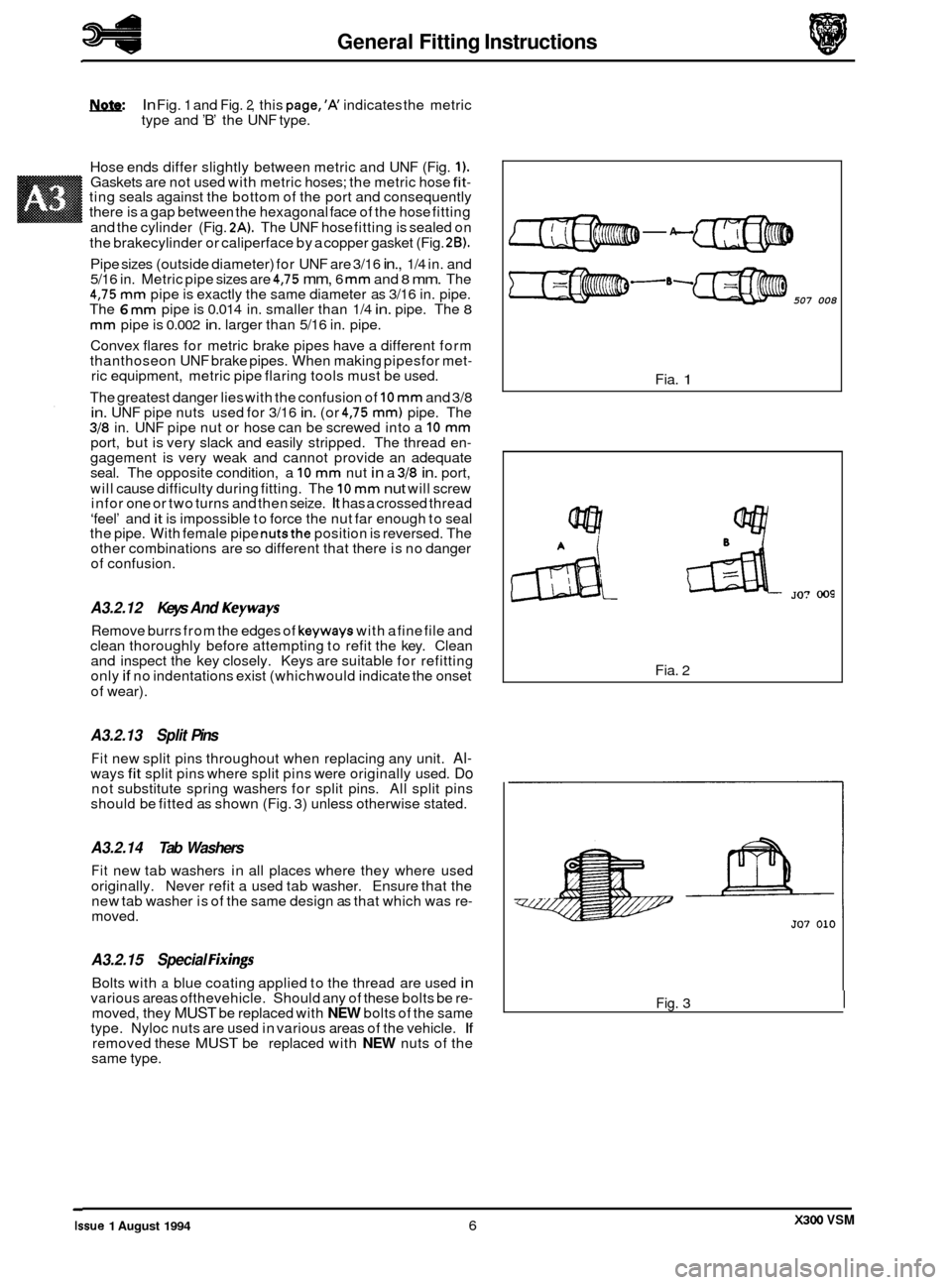
General Fitting Instructions
In Fig. 1 and Fig. 2, this page,’K indicates the metric
type and ’B’ the UNF type.
Hose ends differ slightly between metric and UNF (Fig.
1). Gaskets are not used with metric hoses; the metric hose fit- ting seals against the bottom of the port and consequently
there is a gap between the hexagonal face of the hose fitting
and the cylinder (Fig.
2A). The UNF hose fitting is sealed on
the brakecylinder or caliperface by a copper gasket (Fig.
2B).
Pipe sizes (outside diameter) for UNF are 3/16 in., 1/4 in. and
5/16 in. Metric pipe sizes are 4,75 mm, 6 mm and 8 mm. The 4,75 mm pipe is exactly the same diameter as 3/16 in. pipe.
The 6 mm pipe is 0.014 in. smaller than 1/4 in. pipe. The 8
mm pipe is 0.002 in. larger than 5/16 in. pipe.
Convex flares for metric brake pipes have a different form
thanthoseon UNF brake pipes. When making pipesfor met
- ric equipment, metric pipe flaring tools must be used.
The greatest danger lies with the confusion of
10 mm and 3/8 in. UNF pipe nuts used for 3/16 in. (or 4,75 mm) pipe. The 318 in. UNF pipe nut or hose can be screwed into a 10 mm port, but is very slack and easily stripped. The thread en- gagement is very weak and cannot provide an adequate
seal. The opposite condition, a 10 mm nut in a 318 in. port,
will cause difficulty during fitting. The
10 mm nut will screw
in for one or two turns and then seize. It has a crossed thread
‘feel’ and
it is impossible to force the nut far enough to seal
the pipe. With female pipe nutsthe position is reversed. The
other combinations are so different that there is no danger
of confusion.
A3.2.12 Keys And Keyways
Remove burrs from the edges of keyways with a fine file and
clean thoroughly before attempting to refit the key. Clean
and inspect the key closely. Keys are suitable for refitting
only
if no indentations exist (which would indicate the onset
of wear).
A3.2.13 Split Pins
Fit new split pins throughout when replacing any unit. Al- ways fit split pins where split pins were originally used. Do not substitute spring washers for split pins. All split pins
should be fitted as shown (Fig. 3) unless otherwise stated.
A3.2.14 Tab Washers
Fit new tab washers in all places where they where used
originally. Never refit a used tab washer. Ensure that the
new tab washer is of the same design as that which was re
- moved.
A3.2.15 Special Fixing
Bolts with a blue coating applied to the thread are used in various areas ofthevehicle. Should any of these bolts be re- moved, they MUST be replaced with NEW bolts of the same
type. Nyloc nuts are used in various areas of the vehicle. If removed these MUST be replaced with NEW nuts of the
same type.
-A
507 008
Fia. 1
Fia. 2
Fig. 3 I
X300 VSM Issue 1 August 1994 6